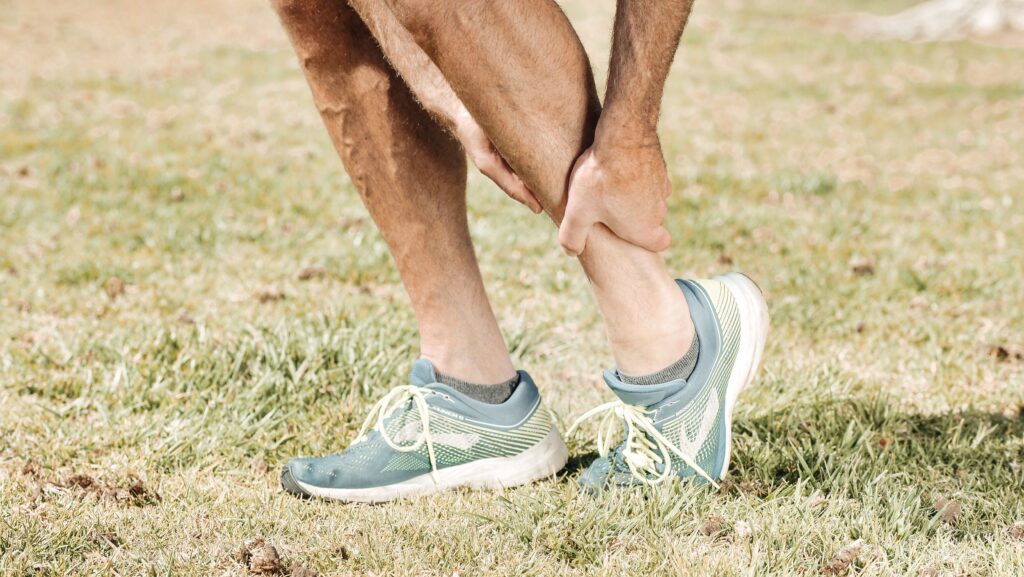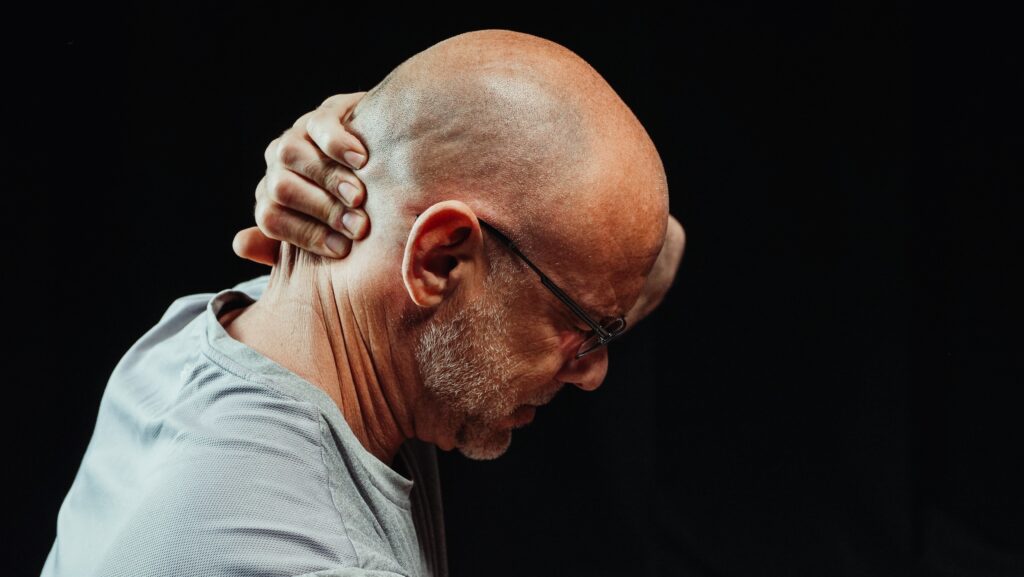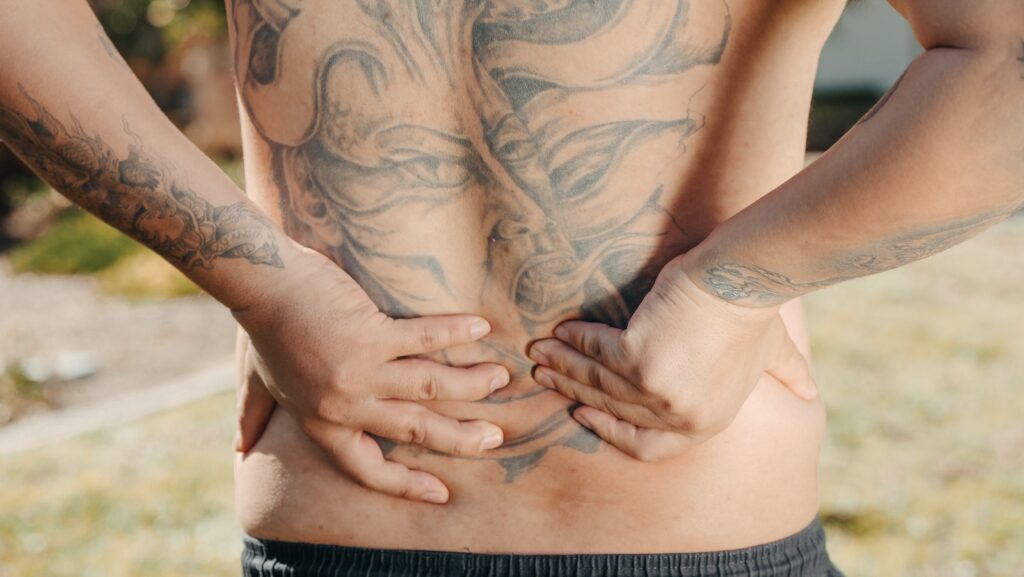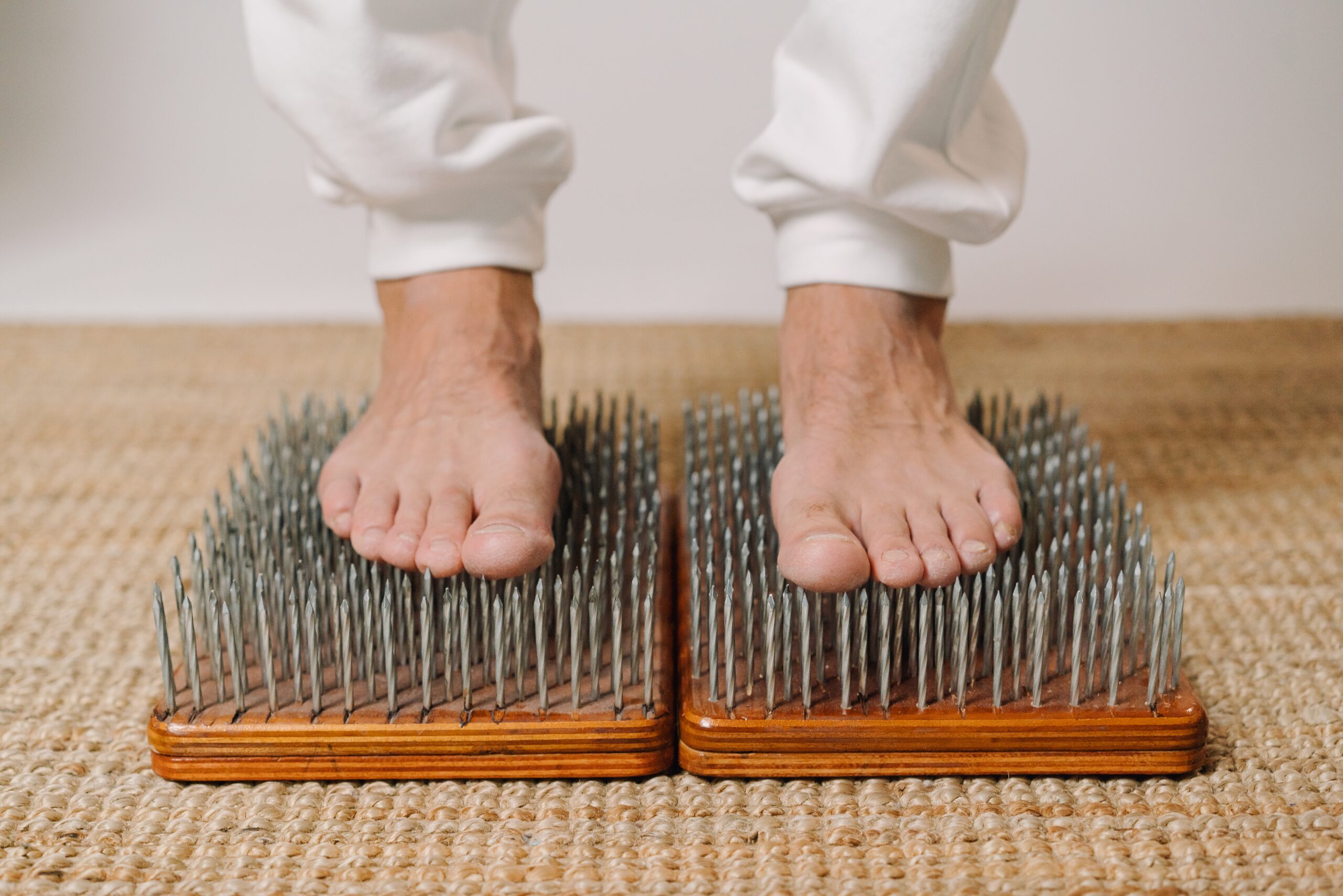
To move well and get out of pain, you must unstiffen yourself. If you’re stiff, you’ll move like a robot. And subsequently, your robot-like lack of physical freedom will put undue strain on the structures of your body that are chronically achy.
I don’t want you to be chronically achy anymore. So please… unstiffen yourself.

In the present article – the second in a 2-part series on how to attain physical freedom and get out of pain – you’ll learn how to fix one of the biggest issues related to stiffness: Poor body awareness. But if you haven’t already done so, first read part 1 where I outline how to address the root of your stiffness. Then come back to learn about the ins and outs of developing better body awareness.
With all that said, let’s jump right into it.
PART 2: DEVELOPING BETTER BODY AWARENESS
Poor body awareness will make you stiff…
Naturally, you’re unable to move parts of your body that you’re not aware of. As a result, those areas that can’t regularly experience movement become locked up. And the knock-on effects of that locked up-ness (stiffness) are twofold.
The more obvious effect is that the locally stiff area will become inflamed and chronically achy. Lack of movement leads to lack of blood and lymph flow. In practical terms, this means that the stiff, locked up areas of your body can’t receive nutrients and/or eliminate waste, respectively. Chronic pain ensues.

The other (and very underdiscussed) effect of poor body awareness and the localized stiffness that it can create is that other areas of your body have to take on extra strain. Those overworked areas tend to be the areas that are chronically achy. As an example, most 9-5 office workers have horribly achy lower backs. Coincidentally, due to the nature of their jobs, they also tend to have horrible awareness and resulting stiffness around their pelvis, ribcage, and skull, among other important structures. So guess what happens? The lower back has to take on all the responsibility that should’ve been distributed evenly across all the other joints of the body. And alas, the poor lower back becomes inflamed and has to endure all sorts of pain.

Beyond specific, localized stiffness, poor body awareness can result in global, full-body stiffness! Modern life is a doozy. Between our convenience-induced diseases of affluence, the attention economy, and hustle culture, we’re constantly in a low-grade state of fight or flight. There’s a name for those mini, oftentimes barely perceptible panic attacks: The startle reflex. And as you might’ve guessed, the startle reflex makes you stiff.
Dr. Frank Wildman, an OG in the mind-body movement game, eloquently explains the startle reflex as “two distinct phases [to the startle reflex]. In the first, you extend your hands, neck and back. You suddenly gasp a breath of air with a wide-open mouth. Your eyebrows go up as your eyes take on a startled expression. This first phase lasts a fraction of a second. Then, within another fraction of a second, your feet grab the floor, your fingers curl, you pull down with slightly bent knees, chin lowered over the throat, rib cage and sternum pulled down over the diaphragm. The muscles in the belly contract to make them hard. The back of the neck is short and tight. The jaw clenches and the eyes take on a fixed stare. The face has a searching expression, but without the mobility to actually scan the environment. You are unable to move. All your muscles are, in effect, holding onto a ball that you don’t throw.”

In short, the startle reflex = full body stiffness. And because it’s a reflex, there’s nothing you can do to stop it from occurring. You can however, upon becoming aware of your body, consciously override the reflex (e.g. via deep breathing, dilating your gaze, feeling your foot pressures). Unfortunately, you may lack the body awareness to recognize when you’re locked in the startle reflex. But we’re going to fix all that today, aren’t we?
Here are the 3 biggest bang-for-your-buck things you can do to improve body awareness:
#1 – Tissue mapping.
A fancy term to describe the process of reminding yourself that you live in a body. Here’s how it works: You rub, slap, tap, thump, and put pressure on areas of your body that your brain has poor awareness of. By poking and prodding yourself in a variety of different ways, you help your brain in building a more accurate sensorimotor representation of your body. Sensory input (you poking and prodding yourself) leads to tighter motor output (fluid and less stiff movement). Sensory input also moves blood and lymph to the stimulated areas. Below is just one example of tissue mapping. You can also foam roll, take cold showers, or use any form of stimulation/sensory input to develop better body awareness. It’s the concept that matters, not any one specific technique.
#2 – Body scan meditations.
If tissue mapping is improving body awareness from the outside in, body scan meditations are the opposite. By improving your internal ability to feel your body (i.e. interoception), you once again end up with better movement quality and circulation. Below you’ll find an example of a type of body scan meditation that I learned from Dr. Jeff Almon. But again, it’s the concept that matters and not the specific technique. If you don’t like the Buzz game, there are dozens if not hundreds of guided body scan meditations on Spotify and YouTube. Play around with them and see which one works best for you.
#3 – Novel movement.
Move in as many different ways as you can. Firstly, it’s the lazy man’s “mobility” training. By expanding your movement vocabulary, you inevitably end up introducing your joints to different, and full(er) ranges of motion. Secondly, it’ll coax you out of dysfunctional movement patterns that may be causing stiffness and pain. As an example, let’s say you walk in a way that begets knee pain, but you decide to try this “novel movement” concept out so you learn how to kickbox and dance. Your brain will then automatically incorporate some of these new movement options that you’ve gained into your previously dysfunctional walking; maybe by allowing your ribcage to flex more, or your feet to squish into the floor more. In any case, the novel movement was a key component to your getting out of your dysfunctional, stiffness and pain-inducing movement patterns. Finally, by moving in as many different ways as you can, you’re improving your balance and coordination – both of which play a hugely important role in allowing for fluid, pain-free movement.

So there you have it! After reading part 1 – how to get your body to chill out, and part 2 – how to improve your body awareness, you should now have a more complete understanding of how to get out of pain and move more freely.
Now I was going to write a part 3 to this series on how to train in a way that unstiffens the body, but I changed my mind because here’s the thing: You’re unique. Your training history is unique. Your injury history is unique. Your goals, strengths, and weaknesses are unique. Even your body proportions are unique. So a one-size-fits-all article on how to train in a way that unstiffens the body? It ain’t gonna work; the specifics of training require a more individualized approach.
In any case, I’ll leave you with this: Part 1 and part 2 of this blog series will get you far on the road to achieving a more pain-free life. But when the day comes (and it will) that you plateau in your efforts for physical freedom, I’d love nothing more than for you to shoot me a message (via email or Instagram) with your specific problems and obstacles. We’ll work together and build you a customized plan to completely unstiffen you once and for all. Until then, best of luck and remember to have fun on your journey!
Pat Koo
BKin, CSCS
Further reading…
- van der Kolk, B. A. (2014). The body keeps the score: Brain, mind, and body in the healing of trauma. Viking.
- Schmidt, R., & Lee, T. (2011). Motor control and learning – 5th edition: A behavioral emphasis. Human Kinetics.
- Pinel, J.P. (2013). Biopsychology (9th edition). Pearson.
- Woolf C. J. (2011). Central sensitization: implications for the diagnosis and treatment of pain. Pain, 152(3 Suppl), S2–S15. https://doi.org/10.1016/j.pain.2010.09.030
- de Jong, M., Lazar, S.W., Hug, K., Mehling, W.E., Holzel, B.K., Sack, A.T., Peeters, F., Ashih, H., Mischoulon, D., & Gard, T. (2016). Effects of mindfulness-based cognitive therapy on body awareness in patients with chronic pain and comorbid depression. Frontiers in Psychology. https://doi.org/10.3389/fpsyg.2016.00967
- Moore, J. E., Jr, & Bertram, C. D. (2018). Lymphatic system flows. Annual Review of Fluid Mechanics, 50, 459–482. https://doi.org/10.1146/annurev-fluid-122316-045259
- Schroeder, J., Wilke, J., & Hollander, K. (2021). Effects of foam rolling duration on tissue stiffness and perfusion: A randomized cross-over trial. Journal of Sports Science and Medicine (20), 626-634. https://doi.org/10.52082/jssm.2021.626
- Wildman, F. (2013). The startle reflex: Our source of chronic pain and stress. Huffpost. https://www.huffpost.com/entry/chronic-pain_b_3661734



Pingback: Unstiffen Yourself (Part 1) - PK Health and Performance
Pingback: Breathing Basics - PK Health and Performance